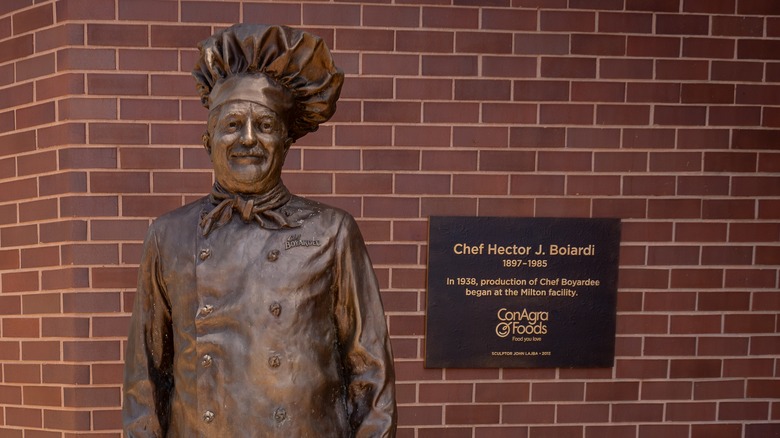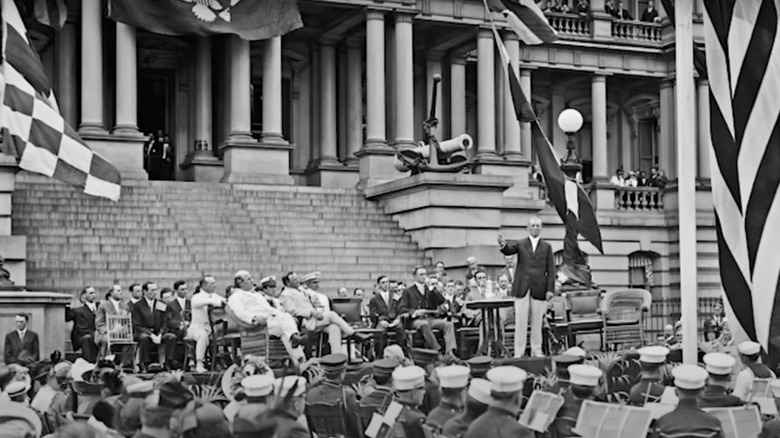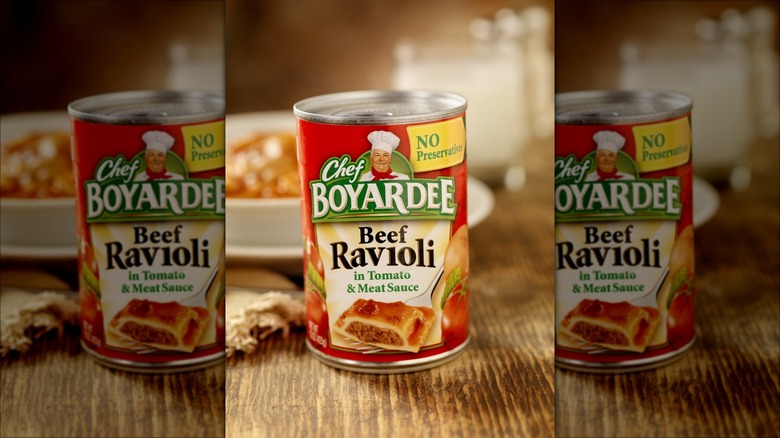How President Woodrow Wilson Put Chef Boyardee On The Map
At the age of 18, most teens have just started to work their first jobs, and they're only a few weeks past their high school commencement. Forget about setting the world on fire. Chef Boyardee, on the other hand, was directing the catering to President Woodrow Wilson's second wedding when he came of age, according to The New York Times. This feat isn't just impressive because of the chef's age but also because he hadn't been in the United States for very long. He was the stuff that American myths were made of. Ironically, he wasn't even old enough to vote for president when he wound up cooking for Wilson on that fateful day.
Born Ettore "Hector" Boiardi, the Italian immigrant landed on American shores in May 1914 when he was just 16 years old, per an Ellis Island passenger record. Just over a year later, in December 1915, the young chef found himself catering the president's wedding to Edith Galt. What he served is unknown, but it's likely that his Italian heritage inspired the nuptial meal.
No doubt about it, Chef Boiardi's cooking prowess made him a boy genius, a fact that likely helped him to get hired at The Greenbrier Hotel in West Virginia, where he was reportedly working when he agreed to cater the president's reception. Oh, and somewhere in between all of this, he managed to become the Head Chef at the Plaza Hotel, too. His early life and career were the stuff that aspiring chefs might only dream about.
Feeding the troops
Chef Boiardi's home-grown Italian cooking seems to have sparked a culinary love affair between the president and the young chef. When it came time to find someone to create a memorable homecoming meal for 2,000 soldiers returning to American shores after World War I, it was Hector Boiardi who the president chose to cater the illustrious affair, Utah Public Radio reported. But Hector's political and military culinary stints extended well beyond cooking for 2,000 men for an afternoon. In 1942, many years after looking after the president and the troops, Chef Boiardi worked out a deal with the U.S. government to make canned food for the soldiers fighting overseas during World War II. By that time, a Chef Boyardee plant existed in Milton, Pennsylvania, which ran 24/7 during the latter part of the war.
His wartime food production efforts turned the canned food industry on its head. It wasn't just the famous chef who showed a patriotic streak during that era, either. His employees were equally patriotic and were known to appear in local parades to bolster morale during the war years. By the conflict's end, Hector Boiardi found himself sporting the civilian award, the Gold Star, for all of the work he and his company did to support the troops during the conflict. The organizational skills and practical know-how he developed after working for and with such high-profile clients over the years undoubtedly helped to prepare him for the opportunities and challenges brought on by the war.
Becoming a household name
Although he enjoyed quite the culinary career on the East Coast, Hector Boiardi decided to move to the Midwest to Cleveland, Ohio, to open his own restaurant. Despite it being ubiquitous today, Italian food was something of an anomaly when the young chef moved to the port city at just 22 years old. He was the person to bring it into the mainstream. His accomplishments made Chef Boiardi the cooking rock star of that era. This likely gave his reputation a leg-up when he opened his own Italian restaurant, Giardino d'Italia, or the Garden of Italy, in 1926. His Northern Italian cooking garnered fans in the city, who loved the sauce he used on his spaghetti and meatballs dish.
Eventually, the chef served milk bottles filled with his red pasta sauce as part of the take-home meal kits he made for the patrons of his eatery. By the time 1928 rolled around, the prodigy chef had started his own food business in rural Pennsylvania. Thanks to the help of some of his restaurant patrons, who worked in the grocery business, his efforts produced what ultimately became the Chef Boyardee company. He chose a phonetic spelling for his name because he thought that the original spelling might be a mouthful — pun intended — for the uninitiated. The company went on to be the maker of everything from canned raviolis to beefaroni, tasty nostalgic treats that kids and youngsters at heart still adore today.


